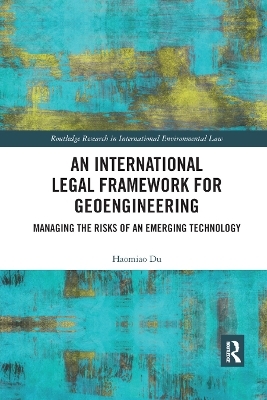
An International Legal Framework for Geoengineering
Managing the Risks of an Emerging Technology
Seiten
2019
Routledge (Verlag)
978-0-367-88878-7 (ISBN)
Routledge (Verlag)
978-0-367-88878-7 (ISBN)
This book responds to the challenges geoengineering poses to International Law by identifying and developing the rules and principles aimed at controlling the risks to the environment and human health arising from geoengineering activities, without neglecting the contribution that geoengineering could make in preventing dangerous climate change.
Geoengineering provides new possibilities for humans to deal with dangerous climate change and its effects but at the same time creates new risks to the planet. This book responds to the challenges geoengineering poses to International Law by identifying and developing the rules and principles that are aimed at controlling the risks to the environment and human health arising from geoengineering activities, without neglecting the contribution that geoengineering could make in preventing dangerous climate change and its impacts. It argues first that the employment of geoengineering should not cause significant environmental harm to the areas beyond the jurisdiction of the state of origin or the global commons, and the risk of causing such harm should be minimized or controlled. Second, the potential of geoengineering in contributing to preventing dangerous climate change should not be downplayed.
Geoengineering provides new possibilities for humans to deal with dangerous climate change and its effects but at the same time creates new risks to the planet. This book responds to the challenges geoengineering poses to International Law by identifying and developing the rules and principles that are aimed at controlling the risks to the environment and human health arising from geoengineering activities, without neglecting the contribution that geoengineering could make in preventing dangerous climate change and its impacts. It argues first that the employment of geoengineering should not cause significant environmental harm to the areas beyond the jurisdiction of the state of origin or the global commons, and the risk of causing such harm should be minimized or controlled. Second, the potential of geoengineering in contributing to preventing dangerous climate change should not be downplayed.
Haomiao Du is a post-doctoral researcher at the University of Twente, the Netherlands
Introduction
Part I – Background
Chapter 1 Political And Scientific Aspects Of Geoengineering
Part II – Applying Contemporary International Law To Geoengineering
Chapter 2 Contemporary International Law And Geoengineering – A General Approach
Chapter 3 Contemporary International Law And Geoengineering – A Technique-By-Technique Approach
Part III Towards Better Governance
Chapter 4 Main Scenarios of the Future of Geoengineering Governance
Chapter 5 Balancing the Risk of Climate Change against Geoengineering – Controlling Environmental Risk and Coping with Scientific Uncertainty
Conclusion
| Erscheinungsdatum | 16.12.2019 |
|---|---|
| Reihe/Serie | Routledge Research in International Environmental Law |
| Verlagsort | London |
| Sprache | englisch |
| Maße | 156 x 234 mm |
| Gewicht | 453 g |
| Themenwelt | Naturwissenschaften ► Biologie ► Ökologie / Naturschutz |
| Recht / Steuern ► Allgemeines / Lexika | |
| Recht / Steuern ► EU / Internationales Recht | |
| Recht / Steuern ► Öffentliches Recht ► Umweltrecht | |
| Sozialwissenschaften ► Politik / Verwaltung | |
| Technik ► Umwelttechnik / Biotechnologie | |
| Wirtschaft ► Volkswirtschaftslehre | |
| ISBN-10 | 0-367-88878-5 / 0367888785 |
| ISBN-13 | 978-0-367-88878-7 / 9780367888787 |
| Zustand | Neuware |
| Haben Sie eine Frage zum Produkt? |
Mehr entdecken
aus dem Bereich
aus dem Bereich


